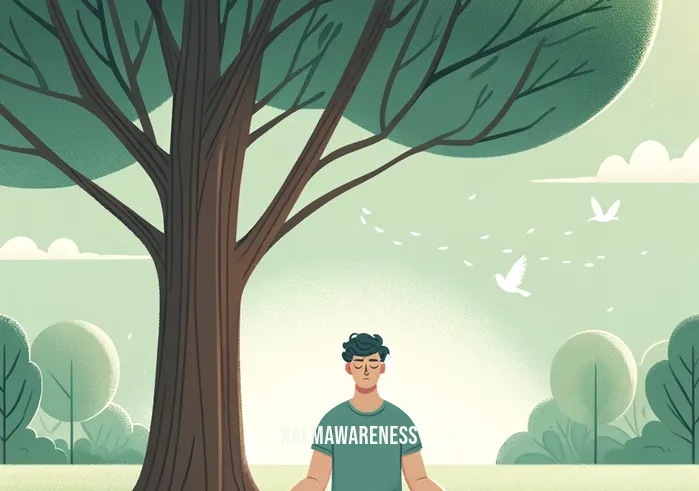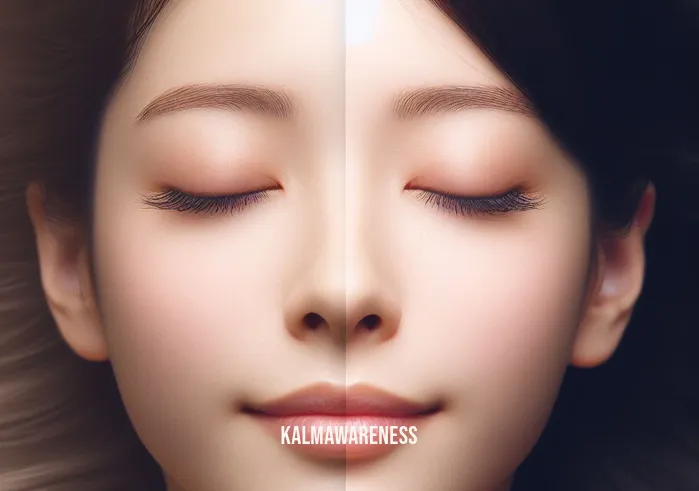Mindfull vs Mindful: The Nuances and Journey of Mindfulness
In our fast-paced world, where distractions are constant and attention is a prized possession, the practice of mindfulness has never been more relevant. But, it’s essential to differentiate between “mindfull” and “mindful”. While “mindfull” suggests a mind filled with thoughts, chaos, and distractions, “mindful” represents a conscious, intentional focus on the present moment. This distinction forms the foundation of the mindfulness journey, where practices like meditation, cognitive psychology tools, and stress reduction techniques come into play. This comprehensive guide dives deep into this topic, shedding light on these practices, their benefits, and their application in our daily lives.
Understanding the Core Difference: “Mindfull” vs “Mindful”
The terms might sound similar, but their implications are distinctively different. Being “mindfull” means having your mind full of thoughts, often clashing and overlapping, leading to mental clutter. This state often results from our habitual thinking, where we fall prey to the same patterns of thought repeatedly.
On the other hand, being “mindful” is about intentional awareness. It’s about anchoring ourselves to the present, often through practices that align our body and mind. For instance, Breathing and Meditation techniques are instrumental in training our minds to be more present and less reactive.
The Power of Being Present
Thich Nhat Hanh, a renowned Zen master, once remarked, “Life is available only in the present moment“. This profound statement captures the essence of mindfulness. When we’re fully present, we can appreciate the beauty around us, better understand our emotions, and develop deeper connections with others.
But how do we cultivate this presence? Various techniques, from mindful martial arts to micro-meditating, help us hone this skill. Each approach offers a unique pathway, emphasizing different aspects of mindfulness, from physical alignment to mental tranquility.
Why Embrace Mindfulness?
The benefits of being mindful are multifaceted. It aids in reducing stress, enhancing emotional intelligence, and improving overall mental well-being. Research also shows that regular mindfulness practices can lead to tangible improvements in our physical health, such as reduced blood pressure and better sleep.
Moreover, embracing mindfulness can transform our daily routines. For instance, practices like mindful hiking or gratitude yoga integrate mindfulness principles into physical activity, leading to both mental and physical rejuvenation.
The Future of Mindfulness
Mindfulness, though rooted in ancient traditions, is adapting to our modern world in exciting ways. For example, tools like the Mindful Harmony app cater to today’s digital generation, making mindfulness techniques more accessible. Moreover, there are specific resources, such as mindfulness books for teens and programs like mindfulness for moms, ensuring that everyone, regardless of age or life stage, can access these powerful practices.
This adaptability and inclusivity of mindfulness underscore its timeless relevance and growing importance in our modern society.
Conclusion
As we embark on this journey of understanding “mindfull” vs “mindful”, it’s evident that embracing mindfulness can lead to a more harmonious, present, and fulfilled life. But the journey doesn’t end here. In the upcoming segments, we’ll delve deeper into specific mindfulness practices, their origins, and their impact on mental health. So, if you’re intrigued by the potential of mindfulness to transform lives, continue reading and explore its multifaceted world in the next segment.

Mindful Martial Arts: The Dance between Consciousness and Action
Delving deeper into the contrast between “mindfull” and “mindful”, it becomes clear that the battle isn’t just mental but also physical. It’s about harmonizing the mind and body to optimize our overall well-being. In this chapter, we’ll traverse the dynamic intersection of mindfulness and martial arts, emphasizing the stark differences between a “mindfull” approach, cluttered with uncontrolled reactions, and a “mindful” approach, hallmarked by precise, intentional actions.
The Role of Mindful Techniques in Martial Arts
In martial arts, every movement counts. Whether it’s the fluidity of Tai Chi or the precision of Karate, being “mindful” enhances the practitioner’s connection with their body, allowing for a heightened sense of awareness and control. Techniques like Rouse Yoga or Gratitude Meditation before Sleep can significantly complement martial arts, teaching individuals to be present in each motion.
However, being “mindfull” in martial arts, constantly bombarded with a plethora of thoughts, can lead to delayed reactions, reduced focus, and potential injuries. This distinction is critical for anyone looking to master or even dabble in martial arts.
Characteristics of a Mindful Martial Artist
Present in the Moment: Utilizing techniques like Jack Kornfield’s Meditation for Beginners, they ensure their focus remains rooted in the present, blocking out past regrets or future anxieties.
Controlled Breathing: Harnessing the power of practices such as Keep it Simple Meditations, they learn to use their breath as an anchor, stabilizing both mind and body.
Intentional Movements: Every action, from a simple step to a complex kick, is performed with intention, ensuring accuracy and efficacy.
Continuous Learning: They understand the journey of martial arts is endless and regularly update their techniques, drawing from diverse resources like Mindful Skills.
Mindfull vs. Mindful: A Comparative Snapshot
| Aspect | Mindfull Martial Artist | Mindful Martial Artist |
|---|---|---|
| Focus | Easily distracted, often lost in a swarm of thoughts | Laser-focused, deeply connected with the present moment |
| Reaction Time | Slower due to mental clutter | Swift and precise, thanks to heightened awareness |
| Injury Proneness | Higher, due to lack of presence | Lower, due to intentional and controlled movements |
| Learning Efficiency | Hindered by recurring patterns of thought | Enhanced by clarity and the application of mindful harmony techniques |
| Emotional Balance | Fluctuates, affected by external factors | Stable, anchored by internal peace and understanding |
Harnessing the True Power of Mindfulness in Martial Arts
Beyond just techniques, the essence of being mindful in martial arts revolves around a deeper connection with oneself. It’s about understanding one’s strengths, weaknesses, fears, and aspirations. It involves leveraging tools like Mindfulness Intentions to set clear goals and visions for one’s martial arts journey.
Moreover, the amalgamation of mindfulness and martial arts offers a holistic approach to life, teaching resilience, patience, discipline, and the value of continuous growth.
Conclusion
While martial arts is a physical discipline, the mental aspect, underscored by the contrast between “mindfull” and “mindful”, is paramount. A mindful approach not only amplifies the benefits of martial arts but also enriches our daily lives, teaching us to be present, intentional, and connected. As we journey ahead, in the next segment, we’ll explore how to transition from a “mindfull” to a “mindful” approach, incorporating tools, techniques, and practices that cater to diverse needs and lifestyles. If the harmonious blend of mind and body intrigues you, continue reading.

From Clutter to Clarity: Inspirational Journeys in Mindfulness
Embarking on the path from being “mindfull” with chaotic thoughts to “mindful” with intentional awareness often requires more than just techniques or practices. It demands inspiration—stories of transformation, hope, and a realization of the profound impact mindfulness can bring. In this chapter, let’s dive into some real-life tales of transformation and uplifting quotes that embody the essence of moving from “mindfull” to “mindful”.
Real-Life Transformations: Tales of Hope
Sarah’s Story: Sarah, a corporate executive, constantly felt overwhelmed. Juggling her professional demands with personal responsibilities made her feel perpetually “mindfull”, weighed down by the cacophony of her thoughts. It was a Mindfulness Consultant who introduced her to Meditation Made Simple. Over time, Sarah found solace in her daily meditation practice. It transformed her from being reaction-driven to response-oriented, a true testament to the power of mindfulness.
David’s Journey: As a college student, David constantly felt the pressures of academic performance. He came across the concept of mindfulness through a Mindful Skills workshop in his university. Initially skeptical, he soon found himself drawn to practices like Gratitude Yoga in Princeton, which changed his approach to stress and life challenges.
Inspiring Quotes to Guide the Mindful Journey
Lao Tzu once remarked, “If you are depressed, you are living in the past. If you are anxious, you are living in the future. If you are at peace, you are living in the present.” This quote beautifully captures the essence of being “mindful” as opposed to “mindfull”, emphasizing the importance of anchoring ourselves to the now.
Jon Kabat-Zinn, the pioneer of Mindfulness-Based Stress Reduction (MBSR), insightfully stated, “You can’t stop the waves, but you can learn to surf.” This perspective encourages us to view our thoughts, especially when “mindfull”, not as disruptions but as waves we can gracefully navigate with a “mindful” approach.
Thich Nhat Hanh, a stalwart in the world of mindfulness, declared, “The present moment is the only time over which we have dominion.” A call to action for everyone who finds themselves lost in the tumultuous sea of “mindfull” thinking.
Eckhart Tolle, in his profound wisdom, expressed, “Realize deeply that the present moment is all you ever have.” A reminder to prioritize our current experiences over the chaos of a “mindfull” existence.
The Ripple Effect of Mindfulness
The stories of Sarah and David are just glimpses into the transformative power of mindfulness. Their journeys underline the importance of tools like Mindful Hiking or initiatives like Mindfulness for Moms that cater to varied demographics and lifestyles.
In essence, the shift from “mindfull” to “mindful” isn’t just about personal growth. It’s about creating ripples in society—when one individual finds peace and clarity, it positively impacts their interactions, relationships, and overall contributions to the community.
Conclusion
The bridge between a “mindfull” and “mindful” existence is often built with bricks of inspiration, personal experiences, and profound insights from visionaries. The stories and quotes shared here serve as beacons of hope, shining light on the transformative journey of mindfulness. As we proceed, the next chapter promises to offer practical tools, techniques, and hands-on practices to guide you further on this enlightening path. If you’re keen to equip yourself with actionable insights, continue reading.
@
From Chaos to Calm: Dissecting the Elements of Mindfulness
The transformative journey from “mindfull” to “mindful” isn’t just about understanding the difference but diving deep into the individual elements that constitute each state. In this chapter, let’s meticulously break down these components, offering insights into their intricacies and exploring how they influence our mental well-being.
Attributes of a “Mindfull” State
Overthinking: One’s mind is incessantly filled with a barrage of thoughts, often leading to analysis paralysis.
Reactive Behavior: Instead of responding to situations, one tends to react impulsively, driven by emotions.
Lack of Presence: There’s a perpetual state of being lost in the past or anxious about the future.
Reduced Clarity: Thoughts overlap, making it challenging to differentiate between essential and non-essential matters.
Physical Manifestations: Symptoms like increased heart rate, shortness of breath, and heightened stress levels often accompany a “mindfull” state.
Components of a “Mindful” State
Intentional Awareness: Actively acknowledging and observing one’s thoughts without judgment.
Responsive Behavior: Situations are approached with calmness, leading to thought-out responses as opposed to impulsive reactions.
Presence in the Moment: Drawing inspiration from techniques such as Meditation Pleine Conscience, one is wholly immersed in the present.
Clarity and Comprehension: Thoughts are organized, making it easier to comprehend feelings and situations.
Physical Calm: With the incorporation of practices like Rouse Yoga, the body experiences reduced stress and increased relaxation.
Mindfulness Techniques to Foster a “Mindful” State
Meditation: A foundational practice that encourages focus and presence. One can start with the basics, drawing guidance from resources like Meditation for Beginners.
Deep Breathing: An immediate way to anchor oneself to the present moment. Techniques like those emphasized in Keep It Simple Meditations can be particularly helpful.
Journaling: Writing down one’s thoughts can provide clarity and perspective, making the shift from “mindfull” to “mindful” tangible.
Mindful Activities: Engaging in activities like Mindful Hiking or practicing Gratitude Yoga in Princeton helps integrate mindfulness into everyday life.
Digital Detox: In our connected world, taking regular breaks from digital devices can significantly reduce the “mindfull” clutter.
Challenges in the Mindfulness Journey
Consistency: Maintaining a regular mindfulness practice amidst busy lifestyles.
Overcoming Skepticism: Many initially approach mindfulness with skepticism, unsure of its benefits.
Navigating Emotional Turbulence: Mindfulness can sometimes bring suppressed emotions to the surface, requiring careful navigation.
Finding Reliable Resources: With the abundance of information available, selecting genuine and helpful resources like the Mindful Miracle can be challenging.
Conclusion
While “mindfull” and “mindful” might sound alike, their components, impacts, and implications are poles apart. Breaking down these concepts offers a roadmap for those keen on transitioning from a state of chaos to calm. As we move to the final chapter of this exploration, anticipate a holistic synthesis of our journey and actionable insights to help you cultivate a mindful existence. If you’re eager for strategies to integrate mindfulness seamlessly into your life, continue reading.
@
Mindfulness Manifested: Reflections on the Voyage from Mindfull to Mindful
As we draw the curtains on our explorative journey of “mindfull” versus “mindful”, it’s essential to pause, reflect, and cherish the insights gained. It’s been a voyage not just of understanding these terms but of diving deep into their essence, their implications, and their profound impact on our well-being.
Journey Recap: Milestones of Mindfulness
From understanding the cluttered realm of a “mindfull” mind to embracing the calm serenity of a “mindful” approach, our expedition has been enlightening. We delved into the transformative stories of individuals like Sarah and David, sought inspiration from luminaries like Thich Nhat Hanh and Jon Kabat-Zinn, and broke down the intricate elements of these states.
Along the way, we discovered a treasure trove of tools and techniques, from Mindful Harmony Apps to Mindfulness Consultants, that act as guides in this journey.
Applying Our Learnings
The true essence of our exploration lies in its application. As you navigate the tumultuous seas of life, remember:
Embrace the present, drawing wisdom from practices like Meditation Pleine Conscience.
Whenever overwhelmed, turn to resources like Mindful Miracle to realign with your mindful self.
Share your mindfulness journey, inspiring others and creating ripples of positive transformation.
Your Next Steps: Embark on Further Explorations
While our current journey concludes here, the broader exploration into mindfulness has countless horizons to discover:
Dive deeper into topics like Mindful Martial Arts to explore the marriage of physicality and consciousness.
Seek solace in practices like Gratitude Meditation before Sleep for a peaceful night’s rest.
A Heartfelt Thank You
To our dedicated readers, thank you for joining us on this enlightening voyage. Your inquisitiveness, your willingness to embrace new ideas, and your journey towards a mindful existence are truly commendable.
Stay tuned for more insightful content in our upcoming editions. And if any concept remains hazy, feel free to revisit previous sections. Remember, the path from “mindfull” to “mindful” is continuous, filled with learning, unlearning, and relearning. We’re here, as your trusted guide, every step of the way.
Embrace mindfulness, cherish the present, and let your journey be filled with moments of clarity and enlightenment.



